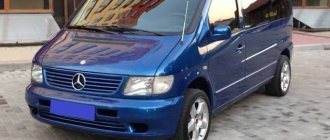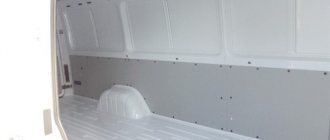Mercedes-Benz Vito 4X4. Arvidsjauri rides
On the eve of sales of the new Vito from Mercedes-Benz Vans in the all-wheel drive version, Daimler decided to introduce the new product in Swedish Lapland - the town of Arvidsjaur
Sergey Zhukov
A dizzying change of planes, the flight was coming to an end when the surroundings of the airport appeared through the windows. What was striking was not the snow-covered landscape, but the frozen lake surfaces lined with trails. Of all those noticed, the largest one stood out. It was she who subsequently became the main character of this event.
It is worth noting that Arvidsjaur is a kind of automobile Mecca. In winter, many automakers come here to test some cars, some tires, and some both together.
So. The new Vito 4x4 from Mercedes-Benz completes the line-up of the latest generation of Vitos recently introduced. It is currently the only mid-size light-duty vehicle available in front-wheel drive, rear-wheel drive and full-time all-wheel drive.
All-wheel drive technology, as they say, is implanted in the rear-wheel drive Vito, with an automatic transmission and a system with electronically controlled brake force distribution. This technology is very closely related to the all-wheel drive solutions used on Mercedes-Benz passenger cars. In the transfer case, torque is redistributed on the axle by the center differential in a ratio of 45:55. The traction force is distributed between the wheels by the time-tested 4ETS electronic traction control system in combination with dynamic driving systems such as ESP and ASR.
One of the features of the new Vito is the downhill speed control system. In all likelihood, it will require a more detailed familiarization with it. After descending a steep hill, she still had questions
The 4ETS system brakes the spinning wheels individually and distributes the traction force to the wheels with good grip in just a split second. Thus, 4ETS provides the effect of using three differential locks (center and cross-axle).
As with the previously presented Vito models, the Vito 4×4 comes as standard with new safety systems - Attention Assist driver fatigue monitoring system and Crosswind Assist crosswind stabilization system.
The new all-wheel drive van boasts not only excellent driving performance on slippery roads or when towing a trailer, but also impressive engine performance. Thus, in the version with the 119 BlueTEC engine, the new Vito 4x4 is equipped with the most powerful engine available - a 2.2-liter 4-cylinder power unit with 190 hp. and maximum torque of 440 Nm.
Thanks to SCR selective exhaust gas cleaning technology, the BlueTEC Vito 4x4 engine design already meets future Euro 6 emission standards. The torque is distributed by the 7G-TRONIC PLUS automatic transmission with torque converter and ECO start/stop function. The Vito 119 BlueTEC 4x4 has a top speed of 199 km/h. At the same time, its fuel consumption (combined NEDC cycle) is only 6.4 l/100 km.
The new permanent all-wheel drive has migrated to the Vito from its passenger counterparts
The compact and relatively lightweight design of the all-wheel drive and the absence of a traditional differential lock contribute to the Vito 4x4's low fuel consumption. And it weighs only 50 kg more than the rear-wheel drive Vito.
The chassis of the new Vito 4x4 has been designed in such a way that the height of the all-wheel drive van is just 1.91 m – i.e. no higher than a Vito with front or rear wheel drive. The Vito 4x4 can therefore access most parking bays and underground car parks and easily carry out transport tasks, also in city centres.
The test drive organizers divided the event into three parts. The first was road, the second was mountain, the third was ice. Since we started early in the morning, the organizers especially asked to pay attention to the ice. The alternation of thaw and frost actively contributed to this.
The first part of the test drive went without any incidents. The car behaved confidently throughout the entire route. We even allowed ourselves to have a little race behind the camouflaged car moving ahead. It turned out to be one of the Range Rover versions.
Next, the organizers organized a “climbing to the peak” and a descent from it. This created the opportunity to test the operation of the new DSR system, which allows the driver to independently regulate (within the permissible range, from 4 to 18 km/h) the speed of rolling down the mountain.
A new attribute of modern LCVs is the AdBlue filler
If at the entrance to a mountain the main task was to choose the correct position of the gas pedal and hold it in this position, then on the descent the task was complicated by adjusting the speed. At first, it was suggested to take your foot off the gas pedal and let the car roll down the steep hill on its own, concentrating only on steering. I won’t lie, it was a little scary. As you got used to it, you could use the lever to slightly increase or decrease the rolling speed. Either we misunderstood something, or the electronics turned out to be thoughtful of our actions, in the end, we refused the services of this system and went back to the old fashioned way.
The third stage of the test drive was supposed to be the most attractive. On a frozen lake with a marked route, replete with various kinds of turns, it was proposed to cover the distance at the maximum possible speed. Three driving modes were planned: with ESP, without it and with low gear engaged. The task was complicated by a three-day thaw, which caused water to appear on the ice. However, at the most interesting place, His Majesty's chance crept up. The “corridor” of the ordered charter was changed, and we all rushed to the airport. In the end, I only managed to drive one lap in ESP mode. The latter pretty much “choked” the car, not allowing you to enjoy the drive. The French ahead managed to turn off this system. This allowed them to go faster, but required certain skills. By the way, one of the crews was thrown onto the snow parapet. The car was pulled out with Gelendevagen.
The Vito's load compartment is more than functional
On the way to the airport, another feature was noticed. The thaw began to turn the road into a snowy mess. It’s not in my rules to trust the machine unconditionally. Therefore, the paddle shifters for the manual control mode of the automatic transmission came in handy. Using lower gears for braking, the car moved much more confidently in the field.
I said nothing about the interior and controls. There is practically nothing to add to what has already been published previously. The only difference is that on this trip too, I mistook the right steering column switch for the automatic transmission a couple of times for something else. In response to my remark about the congestion of the left block, it was gently noted that the owners of Mercedes are happy with everything in this particular arrangement.
It only remains to add that the new Vito 4×4 will be available in Russia in the form of a van, a Mixto cargo-passenger version and a Tourer version in compact, extended and extra-long body versions with a gross weight of 2.8 to 3.05 tons. At the time of the start of sales of the car with a 190 hp engine. can be ordered in the Vito 119 BlueTEC 4×4 modification at the factory price of RUB 2,085,114.80. Other engine options are 136 and 163 hp. will become available over the coming months.
NOTE
PRACTICAL. Having a rearview camera in the car makes parking and working with a trailer easier.
CONGESTION. The left steering column switch block is clearly overloaded.
- Torquey engine, excellent 7-speed automatic transmission, overall comfort
- Changing geometric cross-country ability parameters downward
| Specifications | |
| Wheel formula | 4x4 |
| Curb weight, kg | 1811–1925 |
| Total weight, kg | 3050 |
| Cargo compartment volume, m3 | 6,3 |
| Fuel tank volume, l | 57+10 |
| Engine: | |
| type | diesel, 4-cylinder, in-line, turbocharged, Euro-6 |
| working volume, cm3 | 2143 |
| power, l. With. at min-1 | 190 at 3800 |
| torque, Nm at min-1 | 440 at 1400–2400 |
| Transmission | automatic, 7-speed |
| Suspension: | |
| front | independent |
| back | independent |
| Brakes | disk |
| Tire size | 225/55R17 |
| Price | |
| Basic, rub. | from 2,085,114.8 |
| Service | |
| Factory warranty | 2 years or 200,000 km, whichever comes first |
| Service mileage | 2 years or 25,000 km, whichever comes first |
| Competitors | |
| Volkswagen Transporter T5GP 4Motion | |
MERCEDES-BENZ SPRINTER 316 BLUETEC 4X4
Along the way, to complete the experience, the event organizers provided the opportunity to test the all-wheel drive Sprinter. This is not my first acquaintance with this car, the only difference is that this version was packed with electronics and complied with Euro-6 environmental requirements. More significant is that the previous acquaintance was in the spring in a crushed stone quarry.
Having driven the car on the winter roads of Sweden, I realized that the Sprinter 4×4 is perfectly suited for these conditions. However, it is good in terms of handling on slippery roads, but not cross-country ability. It is quite possible that this particular version (Sprinter 316 BlueTEC) did not have enough torque to gracefully get out of the loose snow on the sides of extremely narrow roads.
The editors recommend:
Why do piston rings stick and how to prevent it?
A traffic police officer searched my car: did he have the right to do so?
Russians may be left without foreign cars: Western automakers have stopped supplying cars to our country
A ship that was transporting cars to Russia was detained in France
Half of the car factories in Russia have closed
News Media2










